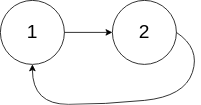142. Linked List Cycle II
Given a linked list, return the node where the cycle begins. If there is no cycle, return null.
To represent a cycle in the given linked list, we use an integer pos which represents the position (0-indexed) in the linked list where tail connects to. If pos is -1, then there is no cycle in the linked list.
Note: Do not modify the linked list.
Example 1:
Input: head = [3,2,0,-4], pos = 1 Output: tail connects to node index 1 Explanation: There is a cycle in the linked list, where tail connects to the second node.

Example 2:
Input: head = [1,2], pos = 0 Output: tail connects to node index 0 Explanation: There is a cycle in the linked list, where tail connects to the first node.

Example 3:
Input: head = [1], pos = -1 Output: no cycle Explanation: There is no cycle in the linked list.

Follow up:
Can you solve it without using extra space?
难度:medium
题目:给定一链表,返回环的起始结点。如果无环返回空。为了表示链表中的环,使用整数来表示起如结点位置即尾结点所指向的位置。如果位置为-1则表示无环。
注意:不要修改链表。
思路:快慢指针。
Runtime: 0 ms, faster than 100.00% of Java online submissions for Linked List Cycle II.
Memory Usage: 35.2 MB, less than 100.00% of Java online submissions for Linked List Cycle II.
/**
* Definition for singly-linked list.
* class ListNode {
* int val;
* ListNode next;
* ListNode(int x) {
* val = x;
* next = null;
* }
* }
*/
public class Solution {
public ListNode detectCycle(ListNode head) {
if (null == head) {
return head;
}
ListNode slow = head, fast = head;
do {
slow = slow.next;
fast = fast.next;
fast = (fast != null) ? fast.next : fast;
} while (fast != null && slow != fast);
if (null == fast) {
return null;
}
for (slow = head; slow != fast; slow = slow.next, fast = fast.next);
return slow;
}
}
正文到此结束
热门推荐
相关文章
Loading...











![[HBLOG]公众号](https://www.liuhaihua.cn/img/qrcode_gzh.jpg)

